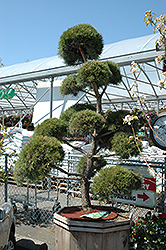Height: 15 feet
Spread: 10 feet
Sunlight:
![]()
Hardiness Zone: 3a
Other Names: Scots Pine
Description:
An ornamental variation of scotch pine with interesting clumped needle growth; this tree must be kept pruned to maintain the pom pom puff effect but is well worth it for the exotic element it will add to your garden
Ornamental Features
Scotch Pine (pom pom) is a dwarf conifer which is primarily valued in the landscape for its ornamental upright and spreading habit of growth. It has attractive bluish-green evergreen foliage. The needles are highly ornamental and remain bluish-green throughout the winter.
Landscape Attributes
Scotch Pine (pom pom) is an open multi-stemmed evergreen shrub with an upright spreading habit of growth. Its relatively fine texture sets it apart from other landscape plants with less refined foliage.
This is a relatively low maintenance shrub. When pruning is necessary, it is recommended to only trim back the new growth of the current season, other than to remove any dieback. Deer don't particularly care for this plant and will usually leave it alone in favor of tastier treats. It has no significant negative characteristics.
Scotch Pine (pom pom) is recommended for the following landscape applications;
- Accent
- General Garden Use
Planting & Growing
Scotch Pine (pom pom) will grow to be about 15 feet tall at maturity, with a spread of 10 feet. It tends to be a little leggy, with a typical clearance of 3 feet from the ground, and is suitable for planting under power lines. It grows at a slow rate, and under ideal conditions can be expected to live for 50 years or more.
This shrub should only be grown in full sunlight. It prefers dry to average moisture levels with very well-drained soil, and will often die in standing water. It is considered to be drought-tolerant, and thus makes an ideal choice for xeriscaping or the moisture-conserving landscape. It is not particular as to soil type or pH. It is highly tolerant of urban pollution and will even thrive in inner city environments. This is a selected variety of a species not originally from North America.
Disclaimer - This resource is provided for informational purposes only and does NOT reflect current availability. Inventory varies seasonally, so we cannot guarantee that every plant will be in stock at all times - please contact your favourite GardenWorks location directly for current availability. It does not include our entire inventory of plants, so be sure to visit GardenWorks to see varieties that may not be represented on this list.

